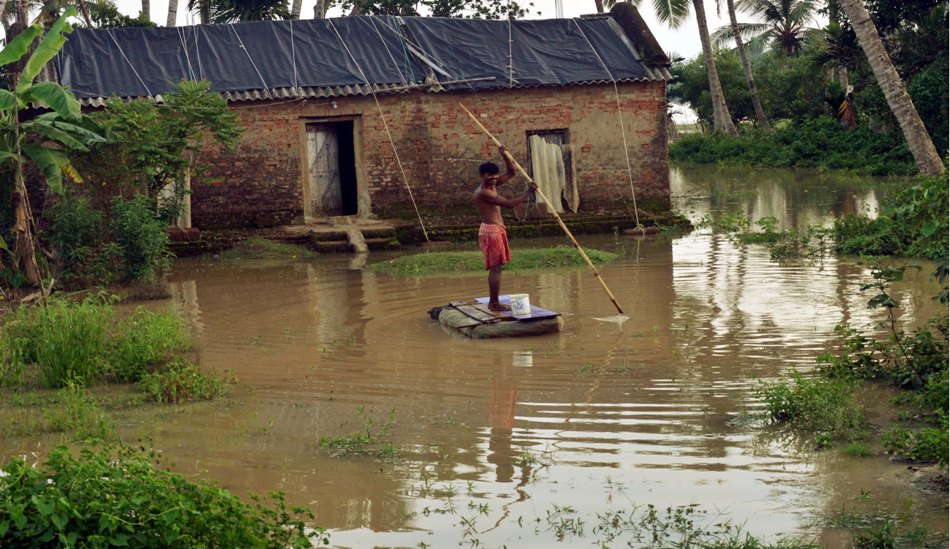Yashobanta Parida & Prakash Kumar Sahoo
In recent times, Odisha has faced natural disasters like cyclones and floods, coupled with the Covid-19 pandemic. The state tried to curb the spread of Covid-19 and took steps to resume economic activities. Natural disasters such as cyclone Amphan added to the government’s fiscal burden.
According to a report from the Ministry of Home Affairs (MHA), 34 persons have been killed due to floods, 4.3 million people have been affected, and 0.12 million have been evacuated in or from 7,528 villages across 27 districts from June 1 to September 2. Moreover, 12,447 houses were damaged as also around 0.38 million hectares of crop area. This was one of the devastating floods that Odisha experienced after the 1999 Super Cyclone. The heavy rainfall in the Mahanadi river’s upper catchment areas and the breaching of river embankments at various locations led to flooding in different coastal districts.
Odisha is highly vulnerable to various natural disasters due to its unique geo-climatic conditions. A high degree of socioeconomic vulnerability, inadequate mitigation measures, low levels of economic development, higher poverty, and high dependency on the agricultural sector have further accentuated the damage caused due to natural disasters.
According to the Human Development Report (2004) published by the state, Odisha lost around 11 per cent of GSDP in 1970, of the order of `10.5 billion. In 1980s and 1990s, the economic losses were seven and ten times the loss suffered in 1970s. Statistics show that, over the period, direct economic losses resulting from natural disasters have increased. Between 1900 and 2011, Odisha experienced 59 incidences of high floods, 24 cyclones, and seven tornadoes. Since the 19th Century, the region has experienced 1.3 natural calamities on average per year.
In addition, 21,832 persons died in six major natural disasters during 1980-2017. Cyclone is one of the most lethal disasters in Odisha that led to a loss of around 10,191 human lives, followed by lightning (8,442), heat-wave (2016), landslide (564), floods (374), and cold wave (245) during the same period.
The geo-climatic conditions such as heavy rainfall during monsoon, inadequate drainage facility, lack of river connectivity, soil erosion, deforestation, breaching of embankments, illegal construction activities in urban areas, unplanned population growth, flood-prone area forming 9 per cent of total state area, and the 482 km long coastline, all contribute to this scenario. Moreover, heavy rainfall during the monsoon in the neighbouring states of Chhattisgarh and Jharkhand aggravates Odisha’s flooding situation. According to a Central Water Commission report, around 1,521 persons were killed due to floods, and 116 million affected over the period 1980-2017. During this period, damage due to floods, including crop, houses, and public infrastructure, stood at `16,278 crore, damage to crop was `1,278 crore, damage to public infrastructure was `14,148 crore, and damage to houses was worth `851 crore.
In addition, every year, Odisha lost around 0.89 per cent of the GSDP due to floods, while damage to crops was around 0.1 per cent of the GSDP. Flood impact also increases the financial pressure on the state government through increased spending on disaster management activities. The state spends around 1.8 per cent of the GSDP on evacuation, relief distribution, rehabilitation, and flood control measures. Floods also affect agriculture, as also public and private infrastructure, among several other aspects. Moreover, it also adversely affects employment opportunities in the rural labour market that leads to increasing poverty.
In the aftermath of the 1999 Super Cyclone, the state government undertook various measures to mitigate the state’s disaster impact. For example, cyclone shelters were constructed in coastal districts along with the setting up of the Odisha State Disaster Management Authority (OSDMA). Other measures include widespread mangroves plantation and regular conduct of cabinet meetings for disaster preparedness. The district-wise Flood Inundation Mapping (FIM) also helps mitigate disaster impact. All these measures helped to minimise the human death toll from cyclones, such as Fani and Amphan.
However, Odisha’s recent flood impact shows that these measures are not adequate. A 2020 article published in the Environment, Development and Sustainability empirically shows that the contemporary level of economic development in districts is not adequate to mitigate flood fatalities in Odisha.
The government would do well to devise a long-term flood management policy along with building flood-resilient infrastructure such as construction and monitoring of river embankments, construction of canals, and improving river connectivity. Other measures include installing a flood warning system in coastal districts, providing pucca houses to beneficiary households, and creating a massive community awareness campaign.
Parida is a research fellow at the Institute of Rural Management, Anand and Sahoo is a lecturer in Economics at Vikram Deb (Autonomous) College, Jeypore.
